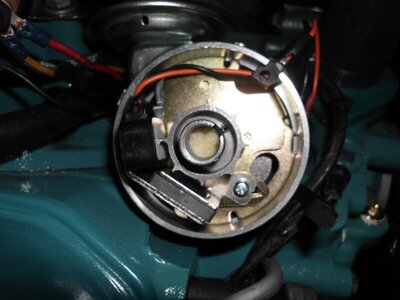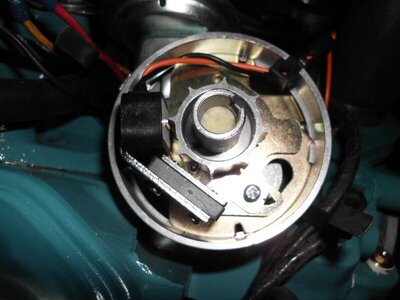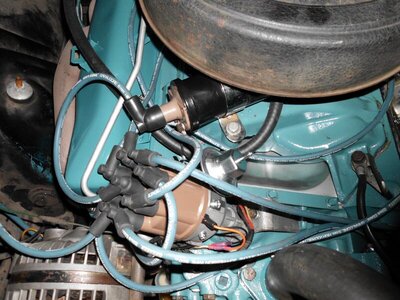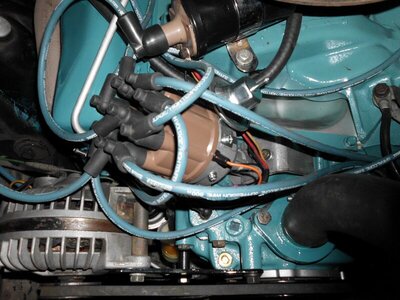I have run them on the machines both ways and have not seen any difference in relation to the spark position also. I am sure there will now be many replies to this.I can tell everyone that I had a 318 A body that came from the factory with the reluctor harness constructed backwards.
It had run like since 1973 with no problems and was not found till I rewired the engine compartment a couple of years ago.
That's all I know.
I'm going to the kitchen and getting Popcorn to find out if that is the problem.
You are using an out of date browser. It may not display this or other websites correctly.
You should upgrade or use an alternative browser.
You should upgrade or use an alternative browser.
Hook up vacuum advance, timing retards appreciably
- Thread starter peabodyracin
- Start date
Gotta agree Don, with a mightyvac hand pump I'd be checking what happens when vac is applied to the can with cap off.Take the cap off and push the arm that attaches to the vacuum canister in towards the canister.
The plate should rotate clockwise.
Try the same thing using a vacuum source, even another car if need be.
Can you tell what maximum advance when purely centrifigal?
I'm thinking it is a reluctor/rotor phasing thing but the math doesn't quite add up.
I've never tried it but you can check for that by drilling a hole near the #1 tower in the cap and I think you put the timing light through it it and see the rotor reference to the tower at various advance points.
Another option is try another distributor, my guess is the problem goes away.
I have one here you can have cheap. PM me if you want to try it.
I have one here you can have cheap. PM me if you want to try it.
- Local time
- 12:36 AM
- Joined
- Jul 1, 2015
- Messages
- 4,577
- Reaction score
- 5,527
THERE IS NO THING CALLED "REVERSE INERTIA". The centrifugual weights will advance the breaker point cam or reluctor tooth wheel AND rotor AHEAD OF THE DIRECTION OF ROTATION. The vacuum advance mechanism moves the only breaker plate OPPOSITE shaft rotation, advancing the spark.and won't advance the mechanical setup either... I guess. But maybe just getting lowered the RPMs after give throttle, due the reverse innertia, somehow.
BOB RENTON
Nacho-RT74
Well-Known Member
Is just a thought
Using the small block driveshaft on a big block, or backwards, the centrifugal advance is also backwards, not just the advance plate move... it could be ( I think ) accidentally activated when rpms are slowing down hard. Just like when you are driving at high speed and press brakes. That's inertia, the resistence of an object on change its velocity or movement... I just called it wrong saying "reverse inertia", my bad...
Using the small block driveshaft on a big block, or backwards, the centrifugal advance is also backwards, not just the advance plate move... it could be ( I think ) accidentally activated when rpms are slowing down hard. Just like when you are driving at high speed and press brakes. That's inertia, the resistence of an object on change its velocity or movement... I just called it wrong saying "reverse inertia", my bad...
Last edited:
Only thing that comes to mind is your not using ported vacuum. From what you posted it is advancing when you hook up the vacuum advance up. Hope it helps.
LA and BB shafts wont interchange and neither will the vacuum advances. Take a picture from the top down with the cap and rotor off for me.
I thought about the ported vs unported vacuum port. Decided vacuum is vacuum, and the only difference should be when it's applied. I did try both anyway, and got pretty similar results.


My guess/experience is the rotor isn't phased properly to the reluctor.... When the vacuum advance pulls in timing the rotor starts throwing sparks at the next terminal on the cap.....
The easy way to check if your distributor cap is "out of phase" is to drill a hole in the top of it that would allow you to see the spark between the rotor and cap terminal. Some caps are so far off that the spark actually jumps to an adjacent terminal.
Ebooger sells the fix...
https://www.ebay.com/itm/MOPAR-Elec...715928?hash=item4b7f811fd8:g:xqUAAOSwBahVGW~j
I'd mentioned in my first post the distributor came from a well known eBay seller....... but I don't wish to malign his good name, so hadn't mentioned it.
Anyway, thanks all for the great comments and plenty more to think about!
I'd mentioned in my first post the distributor came from a well known eBay seller....... but I don't wish to malign his good name, so hadn't mentioned it.
Anyway, thanks all for the great comments and plenty more to think about!
He's a reseller just like everyone else.... I doubt he puts hands on 99% of what he sells, but rotor phasing is real & his fix does work.. So it's worth checking.... If it is the problem maybe he'll cut you a deal on the fix...
- Local time
- 12:36 AM
- Joined
- Jul 1, 2015
- Messages
- 4,577
- Reaction score
- 5,527
Is just a thought
Using the small block driveshaft on a big block, or backwards, the centrifugal advance is also backwards, not just the advance plate move... it could be ( I think ) accidentally activated when rpms are slowing down hard. Just like when you are driving at high speed and press brakes. That's inertia, the resistence of an object on change its velocity or movement... I just called it wrong saying "reverse inertia", my bad...
Your premise is all wrong again.
Perhaps this explains what the phenomenon is: Moment of inertia is defined as the ratio of the net angular momentum of a system to its angular velocity around a principal axis, that is. If the angular momentum of a system is constant, then as the moment of inertia gets smaller, the angular velocity must increase.
OR Inertia means just the state of the body, whether it is in motion or at rest. ... Moment of inertia is the measure of resistance of the object against rotation w.r.t an axis, which is also called as “Second moment of Mass/Area” it varies from axis to axis of the same body.
IF you need a formula to compute it, I can supply the formula....
BOB RENTON
Is that vacuum advance adjustable, where an allen wrench goes in vacuum port and needs adjusting. I know 0 about them, just wondering.
I can tell everyone that I had a 318 A body that came from the factory with the reluctor harness constructed backwards.
It had run like since 1973 with no problems and was not found till I rewired the engine compartment a couple of years ago.
That's all I know.
I'm going to the kitchen and getting Popcorn to find out if that is the problem.
I have run them on the machines both ways and have not seen any difference in relation to the spark position also. I am sure there will now be many replies to this.
Very interesting! I don't doubt what you guys are saying. But, when I switched my wires "for fun" it popped and idled like crap..instantly noticeable.
- Local time
- 1:36 AM
- Joined
- Mar 10, 2010
- Messages
- 29,536
- Reaction score
- 50,999
- Location
- Hanover, Pennslyvania
I thought about the ported vs unported vacuum port. Decided vacuum is vacuum, and the only difference should be when it's applied. I did try both anyway, and got pretty similar results.
View attachment 1000972 View attachment 1000973
When you hook up the vacuum line to manifold it will pull added timing right away even at idle.
Hooking it up to ported won't pull a vacuum at idle and you won't see any timing advancement until you open the throttle a bit.
I'd try 12* to 15* timing without the vacuum hooked up then hook the vacuum line to ported and see how it acts.
Make sure all your plug wires have good contact at each plug also. Loose connection at the plug will cause a popping also.
What's the history on this engine? Has it ran fine before? Has it sat for a long time? Maybe something else is going on and not the dizzy?
If it was rebuilt (in china, for example) they could have gotten the wrong body (A) on the B/RB shaft. They spin opposite so the vacuum advance pulls in a different direction. Just spitballing as it doesn't seem probable.That doesn't make a lick of sense to me......but is it possible to have the wrong advance plate in it?
If you check out the pics he posted of his distrib the can is on the correct side for a bb. The sb would be on the opposite side.If it was rebuilt (in china, for example) they could have gotten the wrong body (A) on the B/RB shaft. They spin opposite so the vacuum advance pulls in a different direction. Just spitballing as it doesn't seem probable.
When you hook up the vacuum line to manifold it will pull added timing right away even at idle.
Hooking it up to ported won't pull a vacuum at idle and you won't see any timing advancement until you open the throttle a bit.
I'd try 12* to 15* timing without the vacuum hooked up then hook the vacuum line to ported and see how it acts.
Make sure all your plug wires have good contact at each plug also. Loose connection at the plug will cause a popping also.
What's the history on this engine? Has it ran fine before? Has it sat for a long time? Maybe something else is going on and not the dizzy?
Thanks for the input. I understood the ported bleed wouldn't work until the throttle opened up. My point was hooking to either port got the same results, just at a different RPM, although I must say it didn't take much RPM change to cause the retarding action with the ported bleed. I'd double checked plug wires, routing, firing order and making sure they're securely fixed on the plug.
The engine consisted of a short block I've had for years, with forged flat top pistons. It had been a good running engine. The heads were a fresh set I've had on the shelf. I had thought about possibly an exhaust valve sticking or not seating properly, so I listened to the exhaust note for some time and it seemed to sound good out of both sides. Rocker arm assemblies were out of a very low mileage engine and look like new. The cam I know was a good used purple shaft which I'd put in it a long time ago but never got back to it. Lifters and lobes on the cam looked like new as well. I replaced the distributor drive gear bushing just for peace of mind, when I assembled the engine. Timing chain was used, double roller, but didn't have 1000 miles on it because I'd pulled it when I converted to a 3 bolt cam setup in a different car. Cam installed straight up: no advance or retard bushings.
With the vacuum advance disconnected the engine sounds very good. Not any sign of a problem. I let it sit and idle for a good 20 minutes. Revs up fine, settles right down and idles well. Tried the advance again on ported bleed, same results. More or less initial timing and same results. As you might expect, with less initial, the exhaust banging gets more pronounced since the timing goes even further ATDC.
Certainly a good mental exercise for me!
I would have switched out that screwed up distributor for a known good one long ago.
Did happen to check if vacuum advance is adjustable? Think a small allen wrench is used to adjustt.
- Local time
- 1:36 AM
- Joined
- Mar 10, 2010
- Messages
- 29,536
- Reaction score
- 50,999
- Location
- Hanover, Pennslyvania
Did happen to check if vacuum advance is adjustable? Think a small allen wrench is used to adjustt.
If the can has a hex shape to it, it should be adjustable with a allen wrench. Thing is he states that it retards the timing when he hooks up the vacuum advance.
Tried the advance again on ported bleed, same results. More or less initial timing and same results.
You could pull a vacuum on the can with the cap off and see which way the advance plate turns. You can use a longer hose and suck on it yourself to see, if you don't have a hand pump.
OK I am kind of thinking the ported vac is not working right and it is giving full vac at idle and when you rev it the engine vacuum decreases so it will retard. That's could why it is the same on both of the ports. Have you hooked up a vacuum gauge yet?Thanks for the input. I understood the ported bleed wouldn't work until the throttle opened up. My point was hooking to either port got the same results, just at a different RPM, although I must say it didn't take much RPM change to cause the retarding action with the ported bleed. I'd double checked plug wires, routing, firing order and making sure they're securely fixed on the plug.
The engine consisted of a short block I've had for years, with forged flat top pistons. It had been a good running engine. The heads were a fresh set I've had on the shelf. I had thought about possibly an exhaust valve sticking or not seating properly, so I listened to the exhaust note for some time and it seemed to sound good out of both sides. Rocker arm assemblies were out of a very low mileage engine and look like new. The cam I know was a good used purple shaft which I'd put in it a long time ago but never got back to it. Lifters and lobes on the cam looked like new as well. I replaced the distributor drive gear bushing just for peace of mind, when I assembled the engine. Timing chain was used, double roller, but didn't have 1000 miles on it because I'd pulled it when I converted to a 3 bolt cam setup in a different car. Cam installed straight up: no advance or retard bushings.
With the vacuum advance disconnected the engine sounds very good. Not any sign of a problem. I let it sit and idle for a good 20 minutes. Revs up fine, settles right down and idles well. Tried the advance again on ported bleed, same results. More or less initial timing and same results. As you might expect, with less initial, the exhaust banging gets more pronounced since the timing goes even further ATDC.
Certainly a good mental exercise for me!
Similar threads
- Replies
- 17
- Views
- 977
- Replies
- 33
- Views
- 3K


















